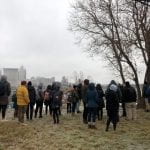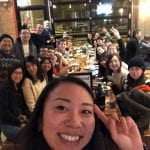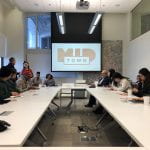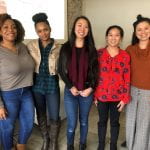
By Nicole Nomura MRP/MLA ’22
Between February 6-7, the landscape architecture studio class (LA 6020, taught by Visiting Critic Mitchell Glass) and the regional planning urban design class (CRP 5850, taught by Associate Professor Jeffrey Chusid) went on a combined site visit to Cleveland, Ohio. As a dual degree student (MRP/MLA), I am in LA 6020 and my class did analyses to learn about Cleveland’s rich history and landscape prior to the trip. We focused on looking at vacant/unused areas along the Penn Rail, an active and major freight line that divides east Cleveland. Our goal is to design with the community in mind, understanding what their vision is and highlighting their attributes.

Our first stop was LAND Studio, a non-profit community organization that serves a multitude of functions. Principal Gregory Peckham welcomed us with lunch and filled us in on their work. Their role was broken down into three C’s: catalyst, convener, and collaborator. They’ve done everything from coordinating local art installations to investing in real estate to working with the community to develop it. One of Cleveland’s major endeavors in revitalizing their community was to repopulate the city with at least 20,000 people in the downtown area by the year 2020. They haven’t reached this number yet, but organizations like LAND Studio are still working with this goal in mind.
Early the next morning we headed to Midtown Cleveland Inc., a community development corporation. Joyce Huang, the director of planning and placemaking, introduced us to their own set of C’s: connections, creating place, communication, and capacity. One of their efforts, Leo’s Listening Party, has been very well received by the community. The party is a series of concerts paying homage to Leo’s Casino, a jazz club that has hosted major figures such as The Supremes, Otis Redding, and Ray Charles. This series has provided an informal forum for people of all ages in the community to connect and share stories from Leo’s era.
I left this meeting inspired by the reports and efforts that Midtown shared with us. We all ate lunch together at Dave’s Markets, a local grocery store founded in the late 1920’s. Before heading back to Ithaca, students were sent out to explore the area further.
About 10 minutes into my walk, my classmates and I were at a busy street intersection when we heard what sounded like four gunshots—but I brushed it off, thinking it was street noise. We later received confirmation that there indeed was a shooting that happened nearby. This was a sobering part of my experience in Cleveland, grounding me in reality. As designers and planners, we often tend to look at our work from above, sometimes glossing over the realities of the community. Although we might not have influence on reducing something like gun violence, the least we can do is respond to the community’s vision and aspirations for wanting a healthier and safer community where they can thrive.



